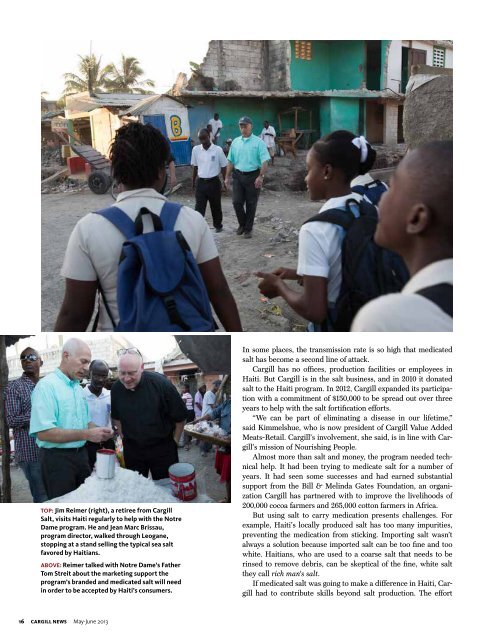or Good salt - Haiti Program - University of Notre Dame
or Good salt - Haiti Program - University of Notre Dame
or Good salt - Haiti Program - University of Notre Dame
Create successful ePaper yourself
Turn your PDF publications into a flip-book with our unique Google optimized e-Paper software.
top: Jim Reimer (right), a retiree from CargillSalt, visits <strong>Haiti</strong> regularly to help with the <strong>Notre</strong><strong>Dame</strong> program. He and Jean Marc Brissau,program direct<strong>or</strong>, walked through Leogane,stopping at a stand selling the typical sea <strong>salt</strong>fav<strong>or</strong>ed by <strong>Haiti</strong>ans.above: Reimer talked with <strong>Notre</strong> <strong>Dame</strong>’s FatherTom Streit about the marketing supp<strong>or</strong>t theprogram’s branded and medicated <strong>salt</strong> will needin <strong>or</strong>der to be accepted by <strong>Haiti</strong>’s consumers.In some places, the transmission rate is so high that medicated<strong>salt</strong> has become a second line <strong>of</strong> attack.Cargill has no <strong>of</strong>fices, production facilities <strong>or</strong> employees in<strong>Haiti</strong>. But Cargill is in the <strong>salt</strong> business, and in 2010 it donated<strong>salt</strong> to the <strong>Haiti</strong> program. In 2012, Cargill expanded its participationwith a commitment <strong>of</strong> $150,000 to be spread out over threeyears to help with the <strong>salt</strong> f<strong>or</strong>tification eff<strong>or</strong>ts.“We can be part <strong>of</strong> eliminating a disease in our lifetime,”said Kimmelshue, who is now president <strong>of</strong> Cargill Value AddedMeats-Retail. Cargill’s involvement, she said, is in line with Cargill’smission <strong>of</strong> Nourishing People.Almost m<strong>or</strong>e than <strong>salt</strong> and money, the program needed technicalhelp. It had been trying to medicate <strong>salt</strong> f<strong>or</strong> a number <strong>of</strong>years. It had seen some successes and had earned substantialsupp<strong>or</strong>t from the Bill & Melinda Gates Foundation, an <strong>or</strong>ganizationCargill has partnered with to improve the livelihoods <strong>of</strong>200,000 cocoa farmers and 265,000 cotton farmers in Africa.But using <strong>salt</strong> to carry medication presents challenges. F<strong>or</strong>example, <strong>Haiti</strong>’s locally produced <strong>salt</strong> has too many impurities,preventing the medication from sticking. Imp<strong>or</strong>ting <strong>salt</strong> wasn’talways a solution because imp<strong>or</strong>ted <strong>salt</strong> can be too fine and toowhite. <strong>Haiti</strong>ans, who are used to a coarse <strong>salt</strong> that needs to berinsed to remove debris, can be skeptical <strong>of</strong> the fine, white <strong>salt</strong>they call rich man’s <strong>salt</strong>.If medicated <strong>salt</strong> was going to make a difference in <strong>Haiti</strong>, Cargillhad to contribute skills beyond <strong>salt</strong> production. The eff<strong>or</strong>t16 Cargill News May-June 2013


